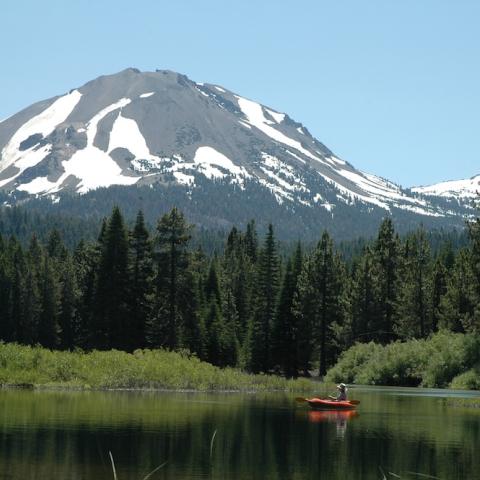
Lassen Peak, the focal point of Lassen Volcanic National Park/Rebecca Latson file
While the Park Fire's northward movement has slowed, if not stopped, crews at Lassen Volcanic National Park continued to work to prepare their park in case the wildfire resumes its march in their direction.
The park located in Northern California closed to the public on Saturday as the Park Fire, started by an arsonist last Wednesday, approached to within 10 miles or so of the park, and within seven miles of park headquarters in Mineral, California, just outside Lassen Volcanic's southwestern entrance.
"Most of what is going on right now in the park is prepping the buildings potentially for the fire encroachment," Sierra Coon, the park's chief of interpretation, told the Traveler on Monday afternoon. "They haven't said that they're wrapping them [with fire retardant material]. What our fire management officer said this morning was that they were putting sprinkler systems on all of the buildings. I know that they're doing things like turning off the propane tanks, and they've moved all the vehicles and they're trying to get rid of possible incendiary things that might contribute to the fire.
"... The main focus, obviously, is the safety and making sure that nothing is on site that will make the fire potentially worse. And protecting the historic structures that are there."
Cultural artifacts were being removed from the historic Loomis Museum, which contained photographs and cameras that Benjamin Franklin Loomis used to capture the Lassen volcano's eruption in June 1914, as well as his seismograph, said Coon.
Loomis and his wife owned land around Manzanita Lake. There they built a home for themselves and a museum for visitors. He even set up a seismic observatory to try to record earthquake data related to the mountain. He donated their land to the park on condition that he and his wife might live there until their lives ended.
Today their home is the ranger station and the museum is the Loomis Museum Visitor Center.
Just three years ago the Dixie Fire marched through Lassen Volcanic, burning more than 73,000 acres and closing the park. Attributed to power lines, the fire started 35 miles southwest of Lassen on July 13, 2021. From outside the park, the fire raced into Lassen's north and northeast sections, entering the southeast corner on August 5. On August 12, a separate fire caused by a lightning strike on Morgan Summit near the park’s Southwest Entrance merged with the Dixie Fire to the northeast. Ultimately, 73,240 acres of the park were impacted, and the fire destroyed or damaged 12 park structures — including the historic Mount Harkness Fire Lookout — before finally reaching 100 percent containment on October 26, 2021.
Mineral and areas of the national park threatened by the Park Fire did not burn during the Dixie Fire.

One of the photos B.F. Loomis took of the May 15, 1915 eruption of Lassen Peak.
Why Is Lassen Volcanic A National Park?
On May 22, 1915, a large explosive eruption of Lassen Peak brought national attention that set the stage for the establishment of Lassen Volcanic National Park on August 9, 1916.
California Congressman John E. Raker had tried unsuccessfully to pass a bill to establish what he originally called Peter Lassen National Park. Just one-seventh the size of Yosemite National Park and lacking a transcontinental railroad for development and promotion, Lassen was not considered monumental enough.
But Lassen Peak's 1914 and 1915 eruptions, especially the eruption captured in a series of six photos by Loomis, changed everything. Excited geologists, volcano enthusiasts, California business organizations, and civic associations generated a new wave of support and Raker successfully ushered the bill through the U.S. Senate. President Wilson signed the Lassen Volcanic National Park Act on August 9, 1916.
Less dramatic eruptive activity continued on Lassen Peak into the 1920s, and the volcano continued to draw attention to the fledging national park. As visitors came to witness the volcanic power of the steaming giant, they began to discover the park's numerous other highlights including its hydrothermal areas, access to four different types of volcanoes found in the world, and countless lakes and streams offering numerous opportunities for recreation enthusiasts.
For many, the focal point of a visit to Lassen Volcanic National Park is a hike to the summit of Lassen Peak. But to really appreciate the volcanic forces that tore the peak open back in May 1915, take a short hike around the Devastated Area Trail.
It's really not a hiking trail, per se, but more of a geologic trail that roams only about a half-mile. But within that half-mile, you're presented with the aftermath of the volcanic eruptions that rained down rocks and boulders, mud, and hot gases — a pyroclastic flow — more than 2 miles from the peak. Photos taken by Loomis show the route the majority of the largest blast took on May 22 clearing a wide path through forests. At the time, U.S. Forest Service officials estimated that the eruption knocked down 5 million board feet of timber.
Today, while the forests have recovered, the might of the eruptions remains clearly visible as you walk through the Devastated Area. Scattered across the forest floor are thousands of rocks that range from roughly football-sized up to one boulder of that will dwarf anyone who stands next to it. The rocks are a mix of black dacite, red dacite, and andesite that were rocketed out of the volcano.




 Support Essential Coverage of Essential Places
Support Essential Coverage of Essential Places







Add comment